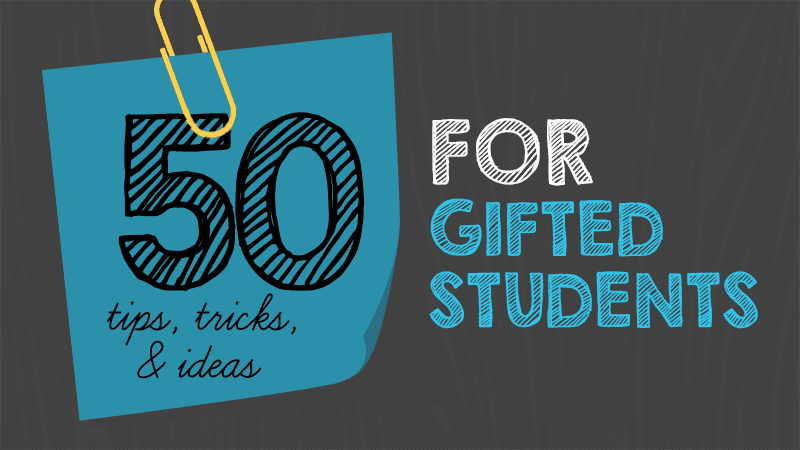Gifted kids can be a joy to teach when you know how to identify what engages them. These 50 tips and tricks come from my own experience and from around the Web. They’re good to have in your bag of tricks whether you’re a newbie or an old hand at teaching these high-level thinkers.
1. Know Their Interests
Every year, I start by having my students complete an interest inventory. This helps me ensure that curriculum is personalized to their interests.
2. Try Book Talks
Share what you are reading with gifted students. Often, these students experience a reading lag where they can’t find a sweet spot because it is hard for high-ability students to understand what is both challenging and appropriate.
3. Keep Them Active
Gifted students often need to have the ability to move when learning … pacing, flapping and bouncing are parts of their thinking process.
4. Offer Flexible Seating
A window seat is my favorite place to read, so I keep that in mind when offering seating. Try to offer different seating options for students: beanbag chairs, carpet squares, pillows, director chairs … the list can go on and on.
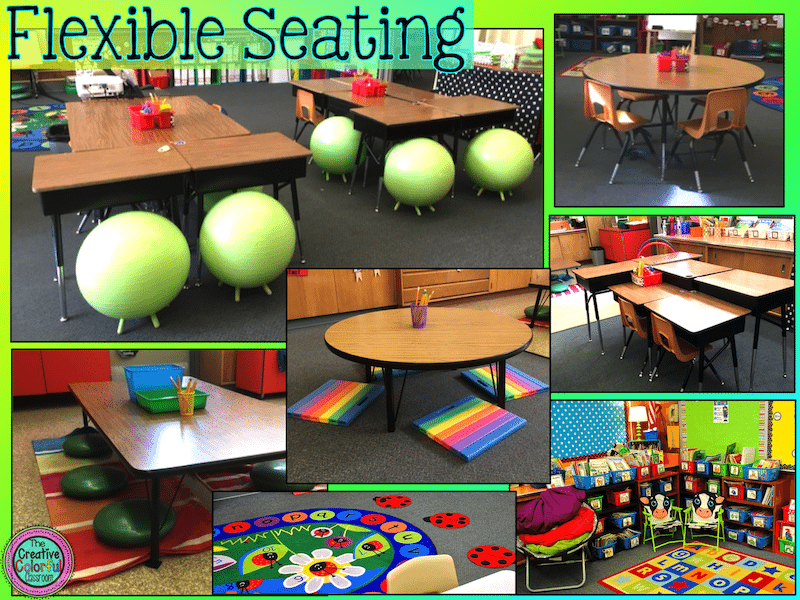
SOURCE: kindergartenisgrrreat.blogspot.com
5. Model Social Situations
Social situations can be challenging for some gifted students as their ability to understand social cues can be underdeveloped. Team up with other teachers to model the proper way to start conversations.
6. Share Current Events
Current events are important to incorporate into gifted programming. We want these students to be thinking about how they can use their talents to solve real-world problems.
7. Look for the Helpers
As important as current events are, it is also just as important to understand that gifted students internalize global happenings on a very personal level. Kids do not have the experience with the world to understand that despite there being a war or attack, there are still good things happening in the world.
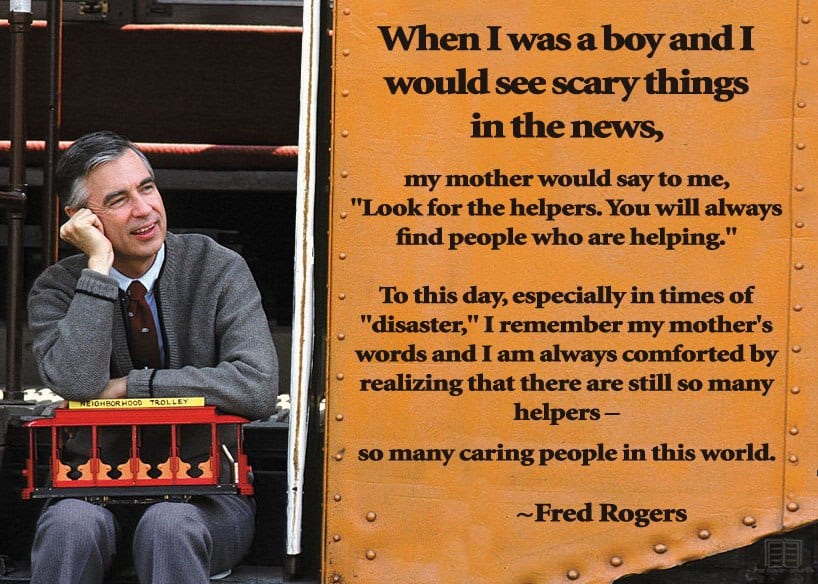
SOURCE: Reddit
8. Allow for Groupings
Not all gifted students are meant to be the project manager. Allow students the opportunity to work alone or in a group. Even cross-grade groupings work well with gifted students.
9. Mind the Child Labor Laws
Gifted students who finish early should not automatically be the teacher’s helper. Gifted students can be some of the worst students to assist others because their brains often work very differently. Having a gifted child help a student who is struggling may do more harm than good.
10. Create a Makerspace
My grandmother always said, idle hands are the devil’s workshop … so keep some key things in the back for busy hands. LEGO bricks, cardboard and masking tape, and Snap Circuits are some of my favorites!
11. Introduce Minecraft Edu
Don’t be scared to incorporate students’ passions and interests. I once had a student who never wanted to practice spelling words until I told him he could practice them in Minecraft. Minecraft Edu has lots of great ways teachers can implement this engaging game in the classroom.
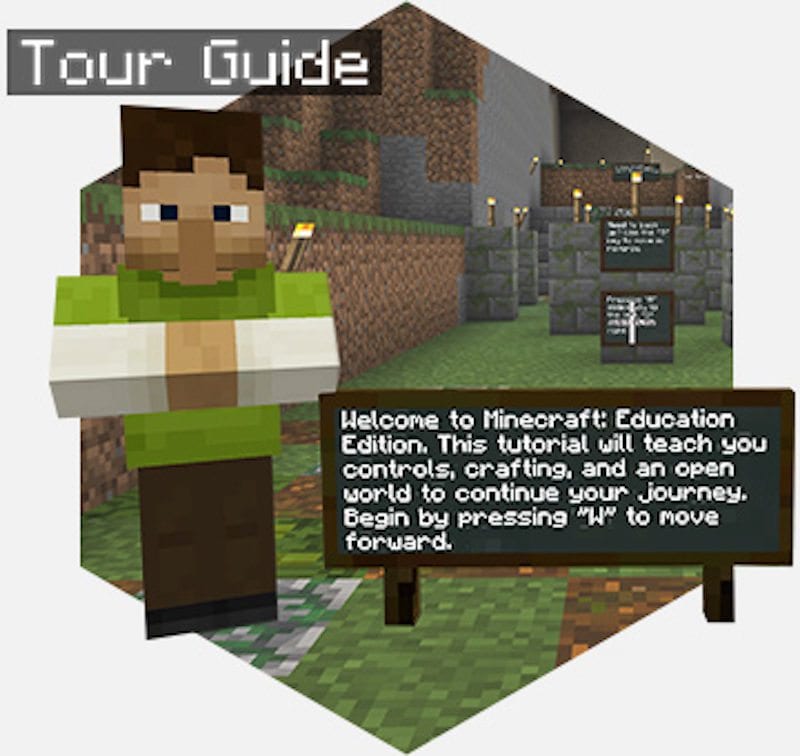
SOURCE: http://education.minecraft.net/
12. Give Them End Dates
Provide gifted students with clear endpoints on projects and assignments. Gifted students can create unusually high expectations and never see an end in sight; a book reflection can easily become a 10-page paper, a PowerPoint can become an intensive course on the topic. Letting students know where to stop can be helpful.
13. Set Realistic Goals
Use FutureMe.org and have students write a letter to their future selves. Once students have written the letter, you can set the date for it to be sent to their inbox. What a great way for students to set goals and create natural check-in points.
14. Teach Decision-Making
Gifted students can have a huge case of FOMO: fear of missing out. They understand that decisions have consequences, and sometimes they need to be given an inordinate amount of details about their options. Allow for the gifted student to fully understand the pros and cons of a decision.
15. Be Patient
Gifted students are processing a lot in their minds. Be patient and give them the time to reflect on what they need to come to a consensus they can live with.
16. Assign Expiration Dates
My gifted students walk into class with exploding folders and binders. They keep everything because there is a fear of being unprepared. Just like expiration dates for food, think about adding a footer to your handouts: “This handout expires on April 15.”
17. Model Organization Strategies
Or at least model how you organize life. Gifted students like options and seeing how they work in the “real world” is very helpful. I show students how I use notes to organize things, how Google Calendar is my lifeline, and what I do for physical notes. I have used planners in the past and show those examples as well.
We also review different apps that could be helpful. I urge students to find what works for them. No system is not an answer. We all need a system to help us be productive. When I taught younger students, we would all try different systems together as our end-of-the-day procedure.
18. Use Brain Breaks
Offer gifted students a hobby that can help calm their busy minds. Teach them how to Zentangle, breathe, meditate, make friendship bracelets, knit, color—anything that allows for them to focus carefully on details can help them quiet some of the extra noise.
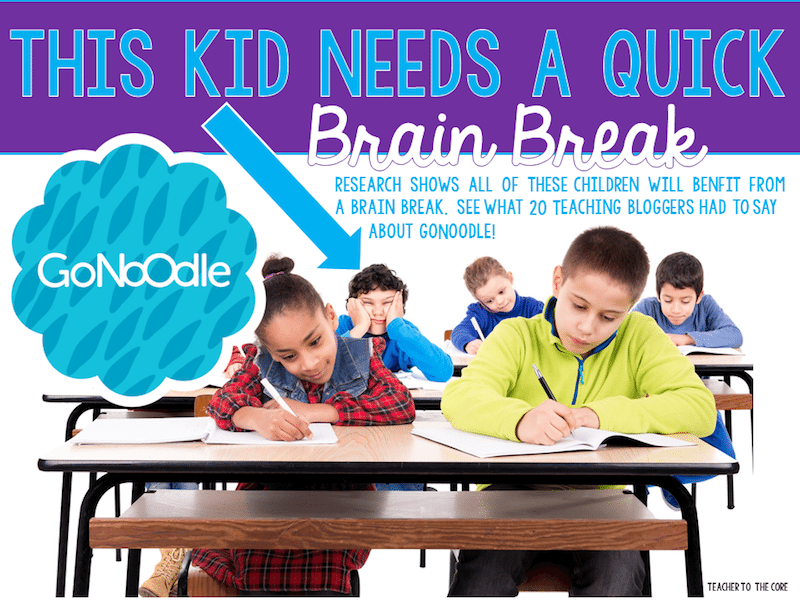
SOURCE: http://teachertothecore.blogspot.com
19. Explore Their Passions
Some gifted students don’t have a passion yet because they haven’t found it. Provide exposure to as much as possible. TED talks are one way to help students think about different topics. TED even has created teaching enhancements. I heart TED.
20. Read Tons of Biographies
Reading, watching or listening to the lives of others can help gifted students develop a plan of action and see what others did to accomplish goals.
21. Read Lots of Everything
It is true, so many gifted students have found a book that becomes so much a part of them, they can discuss it at length. Bibliotherapy is a great way for students to experience how to deal with issues and learn tactics and strategies.
22. Pre-Assess Them
For the love of anything that is holy, this should probably be no. 1. Research states that most gifted students do not learn new information until January. Don’t make a student who has already mastered a concept sit through the lesson again.
23. Allow Them to Focus
Let gifted students pursue their interests. If they want to let everything be about dinosaurs, more power to them! We need paleontologists. As mentioned in Outliers, it takes over 10,000 hours to be an expert. To get that many hours on a time card, students have to be allowed to focus.
24. Make Connections
We need to allow students to hyper-focus but also then be the “guide on the side” that helps them make connections from one area to another. Perhaps we can get our dinosaur expert to use Scratch and make a “Dino Dig” math game?
25. Find Mentors
Gifted students need mentors within their interest areas. Mentors can teach students how to navigate through professions and can even be gatekeepers to additional opportunities.
26. Practice Like Professionals
Allow students to practice like the professionals. Use the same processes that professionals use. Looking to try fashion designing? Have students actually sew, measure, use patterns and do the alterations. Visit the American Museum of Natural History’s OLogy interactive site.
27. Locate Authentic Audiences
The work students create should have a real audience and be appreciated by those who authentically would benefit from its completion. Younger students are a great first authentic audience.
28. Put Them in Escape Rooms
If you haven’t heard of these yet, drop everything and head over to http://www.breakoutedu.com/digital/. These are a great way to curate the knowledge you want your students to gain.
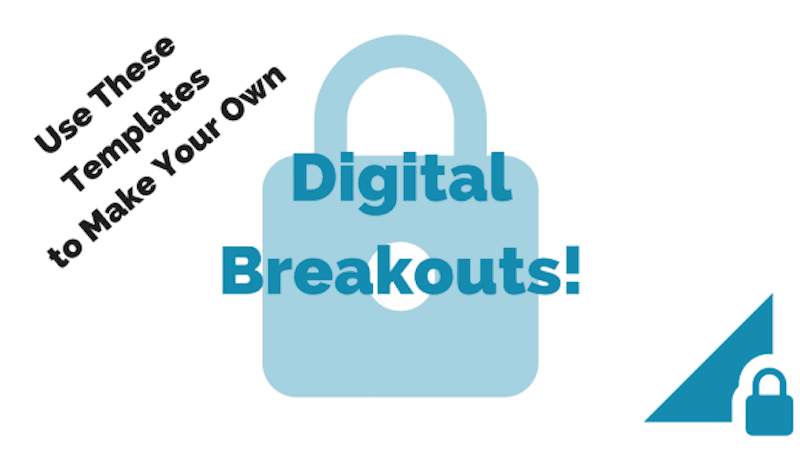
29. Watch Webinars
You can find webinars on just about any topic that interests your students. If you sign up at Edtech, they will send weekly lists of upcoming professional webinars.
30. Submit Inventions
Inventions are a great way for students to take risks and try different things. I feel like students are more apt to take risks when they are creating something new. Student Inventions for a Better America challenges students to submit an invention that will make the world a better place … and there are winners every month.
31. Try Gamification
I love The Mind Research Institute, which challenges students in grades K–12 to design their own mathematical game.
32. Check Out Local Happenings
Do you live in the middle of nowhere? Me too! But I was surprised to learn there were still a TON of events happening on the weekends. If you are in the urban areas, you are rich in opportunities. Look to local libraries, museums or universities.
33. Send Them to Summer Camp
Some of my closest childhood friendships started at summer camp. These times allowed for encouragement and allowed kids to be nurtured in an environment where trying something new was the goal. Summer camp allowed me to be myself and try new things.
34. Solve Local Problems
“With great power comes great responsibility,” says one of our favorite superheroes, and he is correct—kindness counts. We need to do good with the gifts and talents we have been given. Give gifted students the opportunity to solve local problems and see the need for change in their own community. Allow a book to inspire this mission: Wonder, Kindness Club, or The Summer I Changed the World in 65 Days.
35. Develop Book Clubs
What do friends all have in common? Interests!! We are attracted to those who think similarly and those who challenge our beliefs. Book clubs make for a great space for likeminded students to come together to discuss a common theme … in this case a book, which serves as a great discussion starter.
36. Allow for Voice and Choice
How many of you hated a certain book in high school only to read it as an adult and see how wrong you were? The moment we lost choice (of what to read in this case), we also lost joy. Allowing gifted students to have choice in the classroom allows them to feel empowered and engaged. Choices do not need to be huge either, small choices are just as important.
37. Raise the Bar
No one wants to only be the big fish in a small pond. We want to be around people who will make us better and want to achieve more. Allow your gifted student to be challenged by participating in academic competitions such as National History Day. Your students will see what true competition is.
38. Brainstorm
This is one of the best ways to develop critical thinking. Show a picture of clouds … what do you see? This type of activity develops fluency, elaboration, originality and abstract thinking, which are all integral parts of being a creative thinker. Try Google’s Quick, Draw! It’s a great tool for getting students to think rapidly—it’s also a gem for indoor recess.
39. Model Curiosity
When the students ask a question you don’t know, look it up with them. As librarian media specialist Melissa Thom says, “the smartest people are the people who know how to find answers to their own questions.” Follow her on twitter at @msthombookitis.
40. Try Flocabulary
Flocabulary creates content-rich raps (yes, as in hip-hop) about just about ANYTHING. There are so many wonderful resources embedded within—contests, lyric labs, lyric notes, connections to primary sources, teacher plans, corresponding handouts, questioning and so much more! This will quickly become your favorite teaching resource. I promise!

41. Let Them Read Below-Level Books
Why do we expect every book gifted students read to be 1.5–2 grade levels above their reading level? I say, if a student is enjoying a book, read it! Yes, challenging books are needed to develop reading ability but don’t discount a book just because it is below a student’s level. Reading a book for a different purpose can increase the difficulty of a book without changing the text.
42. Connect Globally
Global Read Aloud is a program where one book is used to connect the world. Pernille Ripp founded GRA in 2010 with the simple idea to read a book aloud to her students and during that time try to make as many global connections as possible. This mission has grown exponentially and has reached over two million students. Collaborating with students in other states and countries will help a gifted student think empathetically.
43. Incorporate Mythology
If you know a gifted student, then you know that mythology can be a huge interest—often spurred by the Percy Jackson and the Olympians series by Rick Riordan. Allow students to build a better understanding by incorporating mythology into different curricular units.
44. Blog
This is an authentic way for gifted students to share their reading in a way that we would as adults. Creating readers means treating them like readers—when I finish a book I do not take a comprehension quiz. I talk about it, share it with friends or write about it. Have your students react to reading like real readers. Kidblog is a great tool for creating safe student blogs.
45. Crowdsource
Two heads are better than one! Allow students to go places where they can collaborate. Google Docs is a great place to start, but also explore tools like FlipGrid, a tool that allows students to record and reply to one another.
46. Be a Safe Space
Provide a safe space for gifted students to take risks without being put down. Gifted students are often timid to answer something they are unsure about because of the social stigma attached to not answering correctly. Create a classroom culture where wrong answers become an opportunity to celebrate different thinking. Check out Nancy Anderson’s book, What’s Right About Wrong Answers? Learning Math From Mistakes.
47. Use QR Codes
QR codes add an interactive component to your classroom. Create a QR Code Museum or Gallery or even a QR scavenger hunt on one of your classroom bulletin boards.
48. Write Haikus
A frog jumps into the pond, splash! Silence again. This is Basho Matsuo’s famous haiku. Use haiku as a way to challenge gifted students to summarize chapters, current events, biographies or vocabulary words. Haiku are student-friendly yet force them to be concise and purposeful with their word choice.
49. Change the World
Action is powerful for gifted students. Allowing students to find solutions to problems they see in their school, neighborhood or community will allow them to understand that they can make a difference. Internalizing that they can be the change in the world is transformational. Watch these TED Talks to show them what kids like them are doing to change the world.
50. Record Them
Allow gifted students to record their voices into an app or movie application. Teaching in front of peers is public speaking and that is its own beast. By allowing gifted students to show their work in a way that allows their confidence to be present is a win-win. Explain Everything is a collaborative and interactive whiteboard tool that makes this approach a piece of cake!
